Resistance and immunity
Some plants can tolerate the presence of large numbers of insects without being severely affected. This is not very satisfactory however as insects will still cause damage, and in fact further breeding and population expansion of the pest species is supported. Other varieties are less attractive to pests, but this can be difficult to sustain or demonstrate.
The most valuable form of resistance is where the pest cannot survive as well on one variety as on another. In some cases this can actually make the plants immune to attack, as is the case with the lettuces 'Avoncrisp' and 'Avondefiance' which were bred at the Institute of Horticultural Research, Wellesbourne during the 1960s, which are fully resistant to lettuce root aphid ( Pemphigus bursarius ).
Trade-off of breeding for resistance
Sometimes however there can be a trade-off, for those varieties which have increased immunity or resistance may be lacking in other qualities such as flavour, yield or quality. Celery resistant to the fungus ( Fusarium oxysporum ) may not succumb to this disease, but may also be unacceptably short, ribby and low yielding.
Further, a cultivar that is resistant to one disease may be more susceptible to another that is equally important. A lettuce cultivar that is resistant to mosaic virus may be sensitive to corky root disease, whilst another that resists corky root may be vulnerable to downy mildew (Brim lactic).
Another drawback to resistance is that depending on the host pathogen system, resistance is sometimes not long lasting as new pathogen strains quickly develop, and further research and breeding is constantly needed.
Availability of resistant varieties
Resistant varieties are not available for all crops. For several of the most damaging plant diseases, such as Potato blight (Phytophthora infestans) and white rot (Sclerotic cepivorum) of the Allium genus, no acceptable resistant cultivars are yet available. In addition, commercial seed companies and plant breeders rarely invest resources into developing resistant cultivars for more minor or speciality crops, which often tend to be those of greater interest to the organic grower.
In general it is probably fair to say that resistance will not fully guarantee total crop protection, but choosing resistant varieties should rather be considered as a part of an overall Integrated pest management strategy, especially against virus diseases. In particular they can be especially useful where the threat from specific pests and diseases is high.
Table of resistant crops
The table below illustrates a number of pest and disease resistant vegetable crop varieties, although should not be considered comprehensive.
| Crop | Variety | Comments |
| French Bean | Aigullion | Resistant to bean mosaic virus and anthracnose |
| Hildora | Tolerant of bean mosaic virus |
| Maxi | Tolerant of bean mosaic virus |
| Nektar Queen | Resistant to bean mosaic virus |
| Farba | Resistant to bean mosaic virus |
| Hilda | Resistant to bean mosaic virus |
| Broad Bean | Futura | Tolerant of chocolate spot |
| Brussels sprouts | Cavalier | Resistant to light leaf spot |
| Braveheart F1 | Resistant to powdery mildew and light leaf spot |
| Cabbage | Stonehead F1 | Resistant to mildew |
| Calabrese | Emperor F1 | Highly tolerant of black rot and downy mildew |
| Sampson F1 | Highly resistant to black rot and downy mildew |
| Carrot | Fly Away F1 | Bred for resistance to carrot fly |
| Newmarket | Good resistance to splitting |
| Cucumber | Bush Champion F1 | Resistant to cucumber mosaic virus |
| Marketmore | Resistant to cucumber mosaic virus |
| Burpless Tasty Green F1 | Resistant to mildew and tolerant of heat |
| Slice King F1 | Resistant to downy and powdery mildew, gummosis and angular leaf spot |
| Cumlaude F1 | Tolerant of powdery mildew |
| Media F1 | Tolerant of powdery mildew |
| Leek | Swiss Giant, Zermatt | Moderate rust resistance |
| Alvitta | Rust Tolerant |
| Conora | Good resistance to rust |
| Lettuce | Alexandria | Highly resistant to downy mildew and bolting |
| Lisbusa | Resistant to downy mildew, tolerant of mosaic virus, root aphid and tipburn |
| Sylvestra | Resistant to downy mildew and aphids |
| Little Gem | Resistant to root aphid |
| Barcelona | Resistant to aphids and mildew |
| Iglo | Resistant to downy mildew |
| Revolution | Resistant to mildew and bolting |
| Smile | Resistant to aphids, mildew, tipburn and bolting |
| Parsnip | Avonreister | Very good resistance to canker |
| Gladiator F1 | High resistance to canker |
| Tender and True | Good canker resistance |
| Pea | Ambassador | Resistant to powdery mildew, enation virus and fusarium wilt |
| Cavalier | Good resistance to powdery mildew. |
| Greenshaft | Resistant to downy mildew and fusarium wilt |
| Rondo | Resistant to fusarium wilt |
| Potato (first early) | Colleen | Good resistance to blight and scab |
| Premiere | Resistant to blight and spraing |
| Pentland Javelin | Good all round disease resistance, including golden eelworm and scab |
| Swift | Resistant to golden eelworm and tolerant to blackleg |
| Potato (second early) | Cosmos | Resistant to blight and common scab |
| Osprey | Very resistant to scab and eelworm |
| Potato (maincrop) | Harmony | Very resistant to scab and partially resistant to white and golden eelworm |
| Milva | Blight resistant |
| Remarka | Good all around disease resistance |
| Admiral | Good resistance to blight and scab |
| Cara | Blight resistant |
| Valor | Good overall disease resistance combined with high eelworm and blight resistance |
| Pepper | Bell Boy F1 | Mosaic virus resistant |
| Mandy F1 | Highly resistant to mosaic virus |
| Sweetcorn | Golden sweet F1 | Highly resistant to smut |
| Tomato | Alicante | Good resistance to greenback and mildew |
| Libra F1 | Resistant to fusarium crown and root rot |
| Shirley F1 | Resistant to fusarium, cladosporium and TMV |
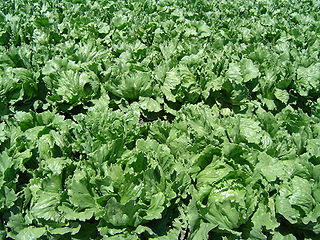
Lettuce is an annual plant of the family Asteraceae. It is most often grown as a leaf vegetable, but sometimes for its stem and seeds. Lettuce is most often used for salads, although it is also seen in other kinds of food, such as soups, sandwiches and wraps; it can also be grilled. One variety, celtuce, is grown for its stems, which are eaten either raw or cooked. In addition to its main use as a leafy green, it has also gathered religious and medicinal significance over centuries of human consumption. Europe and North America originally dominated the market for lettuce, but by the late 20th century the consumption of lettuce had spread throughout the world. As of 2021, world production of lettuce and chicory was 27 million tonnes, 53 percent of which came from China.

Fruit tree propagation is usually carried out vegetatively (non-sexually) by grafting or budding a desired variety onto a suitable rootstock.

Plant pathology is the scientific study of diseases in plants caused by pathogens and environmental conditions. Organisms that cause infectious disease include fungi, oomycetes, bacteria, viruses, viroids, virus-like organisms, phytoplasmas, protozoa, nematodes and parasitic plants. Not included are ectoparasites like insects, mites, vertebrate, or other pests that affect plant health by eating plant tissues and causing injury that may admit plant pathogens. Plant pathology also involves the study of pathogen identification, disease etiology, disease cycles, economic impact, plant disease epidemiology, plant disease resistance, how plant diseases affect humans and animals, pathosystem genetics, and management of plant diseases.

Powdery mildew is a fungal disease that affects a wide range of plants. Powdery mildew diseases are caused by many different species of ascomycete fungi in the order Erysiphales. Powdery mildew is one of the easier plant diseases to identify, as its symptoms are quite distinctive. Infected plants display white powdery spots on the leaves and stems. The lower leaves are the most affected, but the mildew can appear on any above-ground part of the plant. As the disease progresses, the spots get larger and denser as large numbers of asexual spores are formed, and the mildew may spread up and down the length of the plant.

Uncinula necator is a fungus that causes powdery mildew of grape. It is a common pathogen of Vitis species, including the wine grape, Vitis vinifera. The fungus is believed to have originated in North America. European varieties of Vitis vinifera are more or less susceptible to this fungus. Uncinula necator infects all green tissue on the grapevine, including leaves and young berries. It can cause crop loss and poor wine quality if untreated. The sexual stage of this pathogen requires free moisture to release ascospores from its cleistothecia in the spring. However, free moisture is not needed for secondary spread via conidia; high atmospheric humidity is sufficient. Its anamorph is called Oidium tuckeri.

Malus sieversii is a wild apple native to the mountains of Central Asia in southern Kazakhstan. It has recently been shown to be the primary ancestor of most cultivars of the domesticated apple. It was first described as Pyrus sieversii due to its similarities with pears in 1833 by Carl Friedrich von Ledebour, a German naturalist who saw them growing in the Altai Mountains.
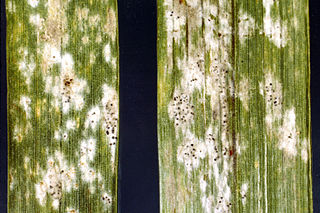
Blumeria graminis is a fungus that causes powdery mildew on grasses, including cereals. It is the only species in the genus Blumeria. It has also been called Erysiphe graminis and Oidium monilioides or Oidium tritici.
Aphanomyces euteiches is a water mould, or oomycete, plant pathogen responsible for the disease Aphanomyces root rot. The species Aphanomyces euteiches can infect a variety of legumes. Symptoms of the disease can differ among hosts but generally include reduced root volume and function, leading to stunting and chlorotic foliage. Aphanomyces root rot is an important agricultural disease in the United States, Europe, Australia, New Zealand, and Japan. Management includes using resistant crop varieties and having good soil drainage, as well as testing soil for the pathogen to avoid infected fields.

Thielaviopsis basicola is the plant-pathogen fungus responsible for black root rot disease. This particular disease has a large host range, affecting woody ornamentals, herbaceous ornamentals, agronomic crops, and even vegetable crops. Examples of susceptible hosts include petunia, pansy, poinsettia, tobacco, cotton, carrot, lettuce, tomato, and others. Symptoms of this disease resemble nutrient deficiency but are truly a result of the decaying root systems of plants. Common symptoms include chlorotic lower foliage, yellowing of plant, stunting or wilting, and black lesions along the roots. The lesions along the roots may appear red at first, getting darker and turning black as the disease progresses. Black root lesions that begin in the middle of a root can also spread further along the roots in either direction. Due to the nature of the pathogen, the disease can easily be identified by the black lesions along the roots, especially when compared to healthy roots. The black lesions that appear along the roots are a result of the formation of chlamydospores, resting spores of the fungus that contribute to its pathogenicity. The chlamydospores are a dark brown-black color and cause the "discoloration" of the roots when they are produced in large amounts.
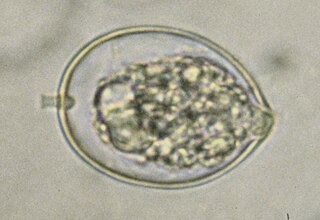
Phytophthora cactorum is a fungal-like plant pathogen belonging to the Oomycota phylum. It is the causal agent of root rot on rhododendron and many other species, as well as leather rot of strawberries.
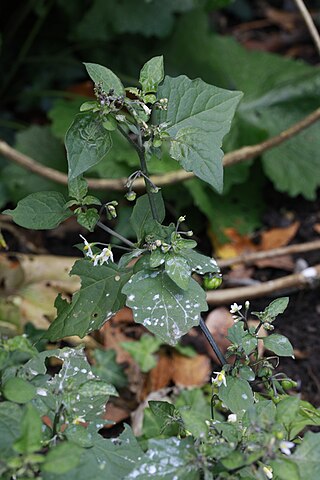
Leveillula taurica is an obligate fungal pathogen, from the phylum Ascomycota, which causes powdery mildew on onion. This disease prefers warm, dry environments. It is rare in the United States, and is currently restricted to western states. Globally, it is also a minor problem with limited occurrences in the Middle East, Europe, and South America. L. taurica causes powdery mildew of onions, but is also known to infect other allium, solanaceous, and cucurbit species. The disease has appeared in parts of the Middle East, the Mediterranean, and South and North America. Currently, it is not a cause for major concern in the U.S. and throughout the world, as its geographic extent is sparse. In addition, it is relatively easy to control through basic sanitation and reducing water stress.

Podosphaera pannosa is a plant pathogen. It produces a powdery mildew on members of the rose family.

Bremia lactucae is a plant pathogen. This microorganism causes a disease of lettuce denominated as downy mildew. Some other strains can be found on 36 genera of Asteraceae including Senecio and Sonchus. Experiments using sporangia from hosts do not infect lettuce and it is concluded that the fungus exists as a quantity of host-specific strains. Wild species, such as Lactuca serriola, or varieties of Lactuca can hold strains that infect lettuce, but these pathogens are not sufficiently common to seriously infect the plant.

Oidium mangiferae is a plant pathogen that infects mango trees causing powdery mildew. Powdery mildew of mango is an Ascomycete pathogen of the Erysiphales family that was initially described by Berthet in 1914, using samples collected from Brazil. O. mangiferae is found in all areas where mangoes have been raised long term, but is particularly widespread in India where both the host and the pathogen are native. Currently no teleomorph stage has been identified, but due to certain morphological characteristics it has been suggested that O. mangiferae belongs in the Erysiphe polygony group. Mango is the only known host for this pathogen, though O. mangiferae appears to be identical to fungi responsible for powdery mildew diseases on various other plant species, particularly oak, though some differences may be observed. In particular, the number of cells in conidiophores varies from 2 on mango to 3-5 on oak. O. mangiferae has been known to infect oak leaves in the laboratory, however due to the lack of a known teleomorph stage O. mangiferae is still considered to only be a pathogen of mango. Recent analysis of its ribosomal DNA suggests it is conspecific with Erysiphe alphitoides, the causative agent of powdery mildew in European oaks.

Napa cabbage is a type of Chinese cabbage originating near the Beijing region of China that is widely used in East Asian cuisine. Since the 20th century, it has also become a widespread crop in Europe, the Americas and Australia. In much of the world, it is referred to as "Chinese cabbage". In Australia it also is referred to as "wombok".

Plant disease resistance protects plants from pathogens in two ways: by pre-formed structures and chemicals, and by infection-induced responses of the immune system. Relative to a susceptible plant, disease resistance is the reduction of pathogen growth on or in the plant, while the term disease tolerance describes plants that exhibit little disease damage despite substantial pathogen levels. Disease outcome is determined by the three-way interaction of the pathogen, the plant and the environmental conditions.
This article summarizes different crops, what common fungal problems they have, and how fungicide should be used in order to mitigate damage and crop loss. This page also covers how specific fungal infections affect crops present in the United States.
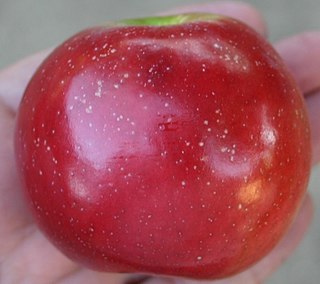
Enterprise is a modern bred, late-ripening and attractive, red cultivar of domesticated apple with excellent fruit quality combined with disease resistance to scab, cedar apple rust, fire blight and some resistance to powdery mildew. The fruit is large and attractive and retains excellent fresh quality for up to six months at 1°C. Its moderate acidity at time of harvest mellows in storage, and it is best after one month of storage.

California is the largest grower of peaches in the United States, producing about 70% of the total.
















